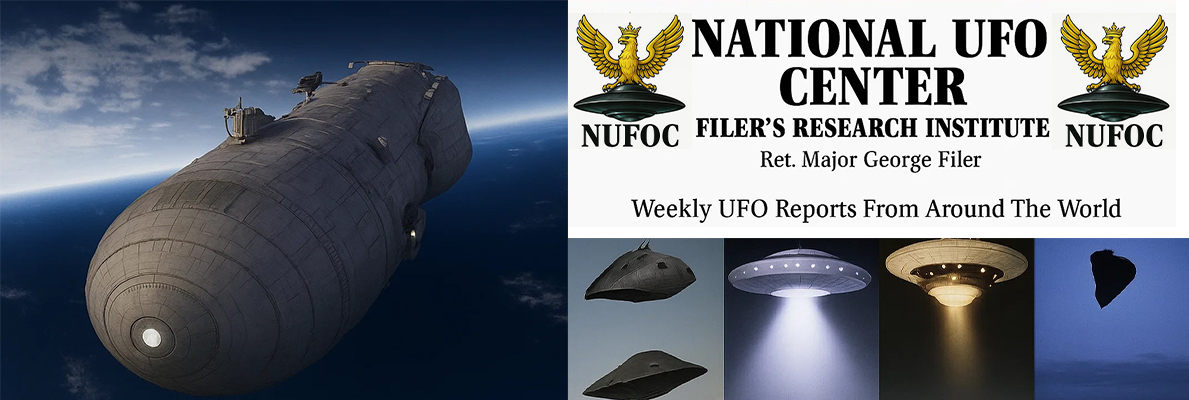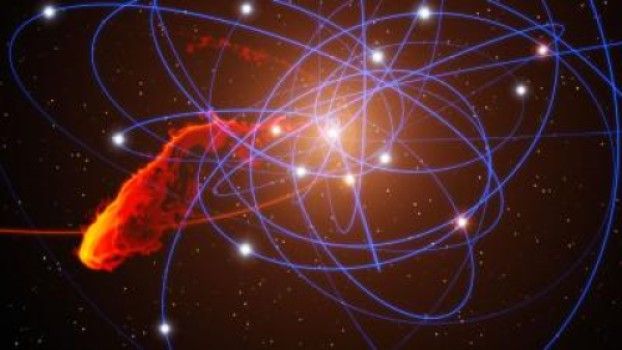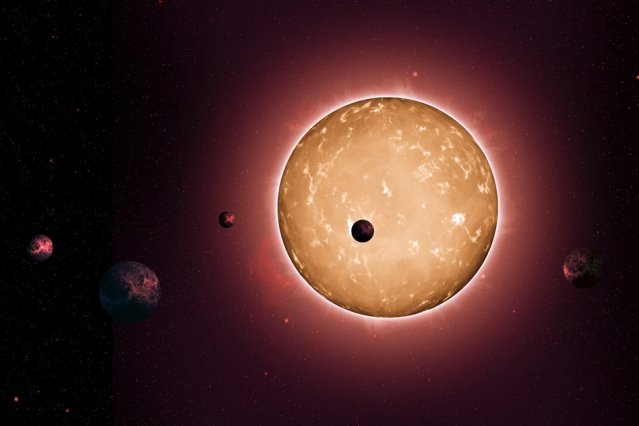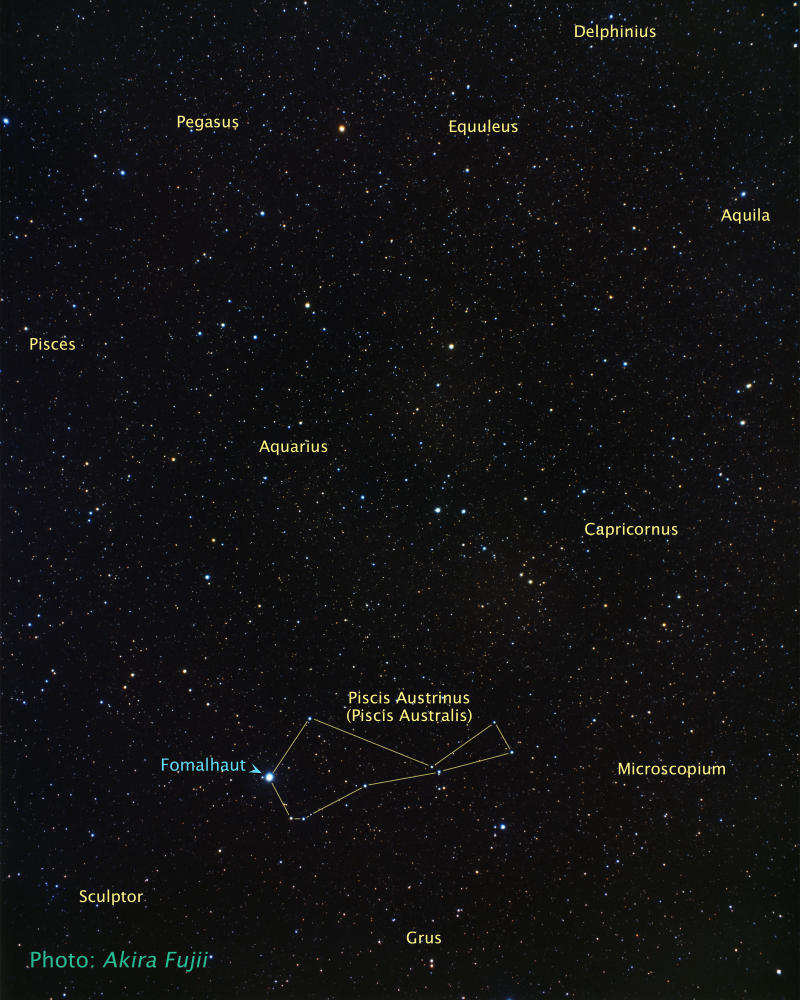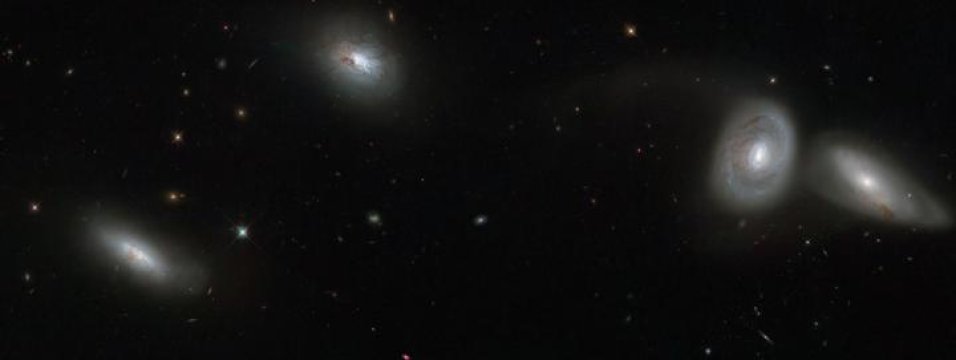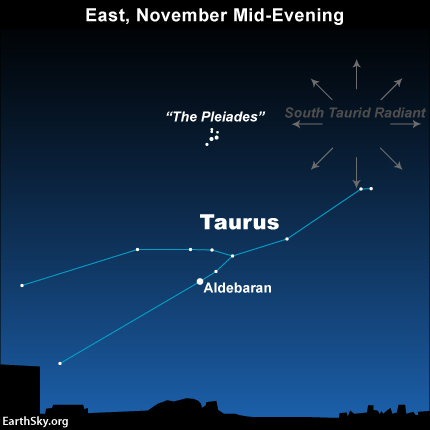
As seen from the northern hemisphere, meteor rates continue to be strong in November. While no major activity is expected this month, the two Taurid radiants plus the Leonids keep the skies active. The addition of strong sporadic rates make November one of the better months to view meteor activity from north of the equator. Skies are fairly quiet as seen from the southern hemisphere this month. Activity from the three showers mentioned above may be seen from south of the equator, but the sporadic rates are much lower than those seen in the northern hemisphere.
During this period the moon reaches its new phase on Sunday November 3rd. At this time the moon will be near the sun and will be invisible at night. Later in this period the moon will enter the evening sky as a slim crescent but will not cause any interference to meteor observers. The estimated total hourly meteor rates for evening observers this week is near 4 for observers located in the northern hemisphere and 3 for those viewing south of the equator. For morning observers the estimated total hourly rates should be near 20 as seen from mid-northern latitudes and near 16 for observers viewing from tropical southern latitudes. The actual rates will also depend on factors such as personal light and motion perception, local weather conditions, alertness and experience in watching meteor activity. Note that the hourly rates listed below are estimates as viewed from dark sky sites away from urban light sources. Observers viewing from urban areas will see less activity as only the brightest meteors will be visible from such locations.
The radiant (the area of the sky where meteors appear to shoot from) positions and rates listed below are exact for Saturday night/Sunday morning November 2/3. These positions do not change greatly day to day so the listed coordinates may be used during this entire period. Most star atlases (available at science stores and planetariums) will provide maps with grid lines of the celestial coordinates so that you may find out exactly where these positions are located in the sky. A planisphere or computer planetarium program is also useful in showing the sky at any time of night on any date of the year. Activity from each radiant is best seen when it is positioned highest in the sky, either due north or south along the meridian, depending on your latitude. It must be remembered that meteor activity is rarely seen at the radiant position. Rather they shoot outwards from the radiant so it is best to center your field of view so that the radiant lies at the edge and not the center. Viewing there will allow you to easily trace the path of each meteor back to the radiant (if it is a shower member) or in another direction if it is a sporadic. Meteor activity is not seen from radiants that are located below the horizon. The positions below are listed in a west to east manner in order of right ascension (celestial longitude). The positions listed first are located further west therefore are accessible earlier in the night while those listed further down the list rise later in the night.
The following sources of meteoric activity are expected to be active this week:
The Andromedids (AND) are active from a radiant located at 01:24 (021) +26, which lies in northern Pisces, 10 degrees northwest of the 2nd magnitude star Hamal (Alpha Arietis).. This is a famous shower that produced some brilliant displays during the 19th century. Since then the main orbit of the particles from comet 3D/Biela have moved away from the Earth. Still, remnants may be seen from October 26 through November 20 with maximum activity occurring on November 8. These meteors are best seen near 2300 (11pm) local standard time (LST) when the radiant lies highest above the horizon. Rates would most likely be less than 1 per hour no matter your location. With an entry velocity of 19 km/sec., the average Andromedid meteor would be of slow velocity.
The Northern Taurids (NTA) are active from a large radiant centered at 03:24 (051) +21, which lies in extreme eastern Aries, some 5 degrees southwest of the famous naked eye star cluster known as the Pleiades. The radiant is best placed near 0100 LST, when it lies highest above the horizon. Meteors from the Northern Taurids strike the atmosphere at 29km/sec., which would produce meteors of slow velocity. Expected rates would be near two per hour, no matter your location.
The center of the large Southern Taurid (STA) radiant is currently located at 03:32 (053) +13. This position lies in western Taurus, near the position occupied by the faint star known 5 Tauri. These meteors may be seen all night long but the radiant is best placed near 0100 LST when it lies on the meridian and is located highest in the sky. Rates at this time should be near 2 per hour regardless of your location. With an entry velocity of 29 km/sec., the average Southern Taurid meteor would be of slow velocity.
The Orionids (ORI) are still active from a radiant at 07:04 (106) +16, which places it in southern Gemini, 5 degrees east of the 2nd magnitude star known as Alhena (Gamma Geminorum). This area of the sky is best placed in the sky near 0400 LST, when it lies highest above the horizon. Rates this week should still be near 3 per hour no matter your location. With an entry velocity of 67 km/sec., most activity from this radiant would be of swift speed.
The last of the Epsilon Geminids (EGE) will be seen this week. The current radiant position would be located near 07:40 (115) +27, which places it in eastern Gemini near the 1st magnitude star known as Pollux (Beta Geminorum). This area of the sky is best placed in the sky near 0500 LST, when it lies highest above the horizon. Current hourly rates should be less than 1 no matter your location. With an entry velocity of 70 km/sec., most activity from this radiant would be of swift speed.
The Zeta Cancrids (ZCN) were discovered by Peter Jenniskens and listed in his book Meteor Showers and their Parent Comets. Recent data from the IMO shows this radiant to be active from November 4-9, with maximum activity occurring on the 7th. The position at maximum activity is 08:03 (121) +14, which places it in extreme southwestern Cancer some 10 degrees northeast of the brilliant 0 magnitude star known as Procyon (Alpha Canis Minoris). This area of the sky is best placed in the sky during the last hour before dawn, when it lies highest above the horizon in a dark sky. Current hourly rates should be less than 1 no matter your location. With an entry velocity of 71 km/sec., most activity from this radiant would be of swift speed.
The Leonids (LEO) are weakly active this week from a radiant located at 09:44 (146) +29. This position is located in northwestern Leo, 5 degrees north of the 3rd magnitude star known as Algenubi (Epsilon Leonis). This area of the sky is best placed in the sky during the last hour before dawn, when it lies highest above the horizon in a dark sky. Current hourly rates should be near 1 as seen from the northern hemisphere and less than 1 as seen from south of the equator. With an entry velocity of 71 km/sec., most activity from this radiant would be of swift speed.
As seen from the mid-northern hemisphere (45N) one would expect to see approximately 10 sporadic meteors per hour during the last hour before dawn as seen from rural observing sites. Evening rates would be near 3 per hour. As seen from the tropical southern latitudes (25S), morning rates would be near 7 per hour as seen from rural observing sites and 2 per hour during the evening hours. Locations between these two extremes would see activity between the listed figures.
The table below presents a list of radiants that are expected to be active this week. Rates and positions are exact for Saturday night/Sunday morning except where noted in the shower descriptions.
| SHOWER | DATE OF MAXIMUM ACTIVITY | CELESTIAL POSITION | ENTRY VELOCITY | CULMINATION | HOURLY RATE | CLASS |
| RA (RA in Deg.) DEC | Km/Sec | Local Standard Time | North-South | |||
| Andromedids (AND) | Nov 08 | 01:24 (021) +26 | 19 | 23:00 | <1 – <1 | III |
| Northern Taurids (NTA) | Nov 11 | 03:24 (051) +21 | 29 | 01:00 | 3 – 2 | II |
| Southern Taurids (STA) | Oct 10 | 03:32 (053) +13 | 29 | 01:00 | 2 – 2 | II |
| Orionids (ORI) | Oct 22 | 07:04 (106) +16 | 67 | 04:00 | 3 – 3 | I |
| Epsilon Geminids (EGE) | Oct 22 | 07:40 (115) +27 | 70 | 05:00 | <1 – <1 | II |
| Zeta Cancrids (ZCN) | Nov 07 | 08:03 (121) +14 | 71 | 05:00 | 1 – 1 | IV |
| Leonids (LEO) | Nov 18 | 09:44 (146) +29 | 71 | 07:00 | 1 – <1 | I |
